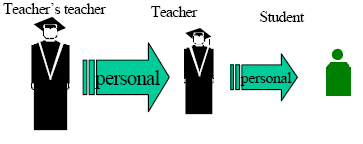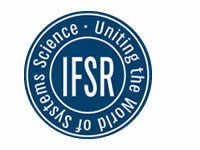IFSR Newsletter 1999 Vol. 18 No. 1 April
Gerhard Chroust
Kepler University Linz, Austria
This is a summary of a paper given at STIQE-98
Mankind depends on communication and has in the past invented and employed many different technologies for it. The ability to disseminate information and knowledge is one of the keys to scientific research. We try to stand on the shoulders of giants as Isaac Newton once put it.
Information has to be forwarded by some appropriate medium. New communication technologies will have a strong impact on the education paradigm. The changes of this medium over the past implied changes of the way scientific information is disseminated. Four means of transport effected major changes:
- In the oral tradition (Fig.1) the information was passed personally from teachers to students; some of them later became teachers. The limitation of oral dissemination and the difficulty of access of more than one teacher resulted in a very lean dissemination tree.

Fig. 1: Oral Tradition, Gerhard Chroust, IFSR Newsletter 1999 Vol 18 No 1 April
- Handwritten books (Fig. 2) were expensive to produce and to reproduce. They contained the knowledge of previous teachers. So a certain extent they replaced the teacher’s teacher and thus essentially broke the direct link.

Fig. 2: Handwritten Book, Gerhard Chroust, IFSR Newsletter 1999 Vol 18 No 1 April
- The printed book, produced in quantities, allowed the establishment of a knowledge base (Fig. 3). The ‘state of the art’ could now be collected and maintained in many places. The personality of the author – the teacher’s teacher lost much of its impact. The written text was the yard stick..

Fig. 3: Printed Book, Gerhard Chroust, IFSR Newsletter 1999 Vol 18 No 1 April
- The World Wide Web (Fig. 4) allows ‘individual self-promotion’. Anybody is able to put a ‘publication’ into the internet, be it a scientist or a ignoramus. No quality control exists. Everybody has easy access to this ‘published’ material. The concept of the state-of-the-art is diluted.

Fig. 4: World Wide Web, Gerhard Chroust, IFSR Newsletter 1999 Vol 18 No 1 April
This development forces us to re-think some of the academic traditions established over centuries. Some obvious effects are (and more should be discovered and discussed):
- easy access from memorising facts to ad-hoc searching
- on-line information from collector to hunter
- uncontrolled publishing from blind believer to critical reader
- just-in-time-publishing from carefully prepared information to suddenly emerging new ideas
Both teachers and students must be made aware and trained to use the new techniques, to understand the consequences and define a new paradigm of education, especially at the universities. We will move from a ‘Know-What’ to a ‘Know-Where’ and ‘Know-How’ paradigm. Are we prepared for it?
Chroust, G. New Reading, New Learning, New Teaching – Will the University System change?
in: Rebernik, M., Mulej, M.: ‘STIQE ’98 – Proc. of the 4th Int. Conf. on Linking Systems Thinking, Innovation, Quality, Entrepreneurship and Environment, pp. 19-29,
Slovenian Soc. for Systems Research, Maribor,
